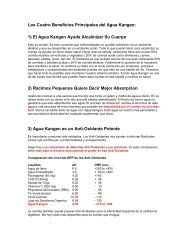ACID-ALKALINE BALANCE: ROLE IN CHRONIC ... - My Kangen Tools
ACID-ALKALINE BALANCE: ROLE IN CHRONIC ... - My Kangen Tools
ACID-ALKALINE BALANCE: ROLE IN CHRONIC ... - My Kangen Tools
You also want an ePaper? Increase the reach of your titles
YUMPU automatically turns print PDFs into web optimized ePapers that Google loves.
THOUGHTS AND PROGRESS<br />
987<br />
(e.g., on neutrophils, fibroblasts, and endothelial<br />
cells even at dilute concentrations of 2.5 × 10 −2 % to<br />
2.5 × 1 −4 % (12). Furthermore, wounds created on<br />
mouse ears and treated with 0.25% sodium hypochlorite<br />
showed delayed epithelialization and neovascularization<br />
(13). This might be the reason that<br />
HOCl was without effect in our wound healing model.<br />
In conclusion, acid and neutral anode chamber<br />
waters accelerated the healing of full-thickness cutaneous<br />
wounds in rats. This effect might be caused by<br />
the generation of reactive oxygen species; however,<br />
further study is necessary for the elucidation of the<br />
mechanism underlying the effects of electrolyzed<br />
water on wound healing.<br />
FIG. 1. Shown are electromagnetic spectra of acidic anode<br />
chamber water. The upper line is for untreated acidic anode<br />
chamber water. There was no significant ESR spectrum. Note<br />
that the lower line, the spectrum of the same water with ferric salt<br />
added, shows 4 lines suggestive of hydroxyl radicals.<br />
in the initiation of healing (6) in this model. In our<br />
study, differences in pH could not account for the<br />
significant difference in the acceleration of wound<br />
healing between acidic (pH about 2.5) and neutralized<br />
(pH 7.4) anode chamber waters on the one<br />
hand, and acidic cathode chamber water (pH about<br />
3.8) on the other. Furthermore, there was no difference<br />
in pH or ORP between neutralized anode<br />
chamber water (pH 7.4, ORP 749–784 mV) and<br />
HOCl (pH 7.45, ORP 780 mV). Thus, ORP presumably<br />
did not substantially affect wound healing in our<br />
experiment.<br />
Reactive oxygen species were shown to affect<br />
DNA synthesis and proliferation in fibroblasts. A<br />
low level of these species stimulates DNA synthesis<br />
and cell division while a high level inhibits DNA<br />
synthesis (the cytotoxicity induced being proportional<br />
to the level of reactive oxygen species) (7–9).<br />
Moreover, in small amounts, reactive oxygen species<br />
were shown to be involved in the mechanism underlying<br />
fibroblast chemotaxis into sites of injury or inflammation<br />
(10).<br />
To our knowledge, there is no report clearly explaining<br />
the direct beneficial effect of HOCl on<br />
wound healing. HOCl generates not only chlorine<br />
gas, which is the main cause of the bactericidal effect<br />
of HOCl, but also singlet oxygen, which is a reactive<br />
oxygen species whose physiological effect is still unknown<br />
(11). Kozol et al. demonstrated that sodium<br />
hypochlorite had toxic effects on wound modules<br />
Acknowledgement: The authors owe grateful thanks to<br />
Dr. Yuko Nishimoto for valuable discussion.<br />
References<br />
1. Tanaka H, Hirakata Y, Kaku M, Yoshida R, Takemura H,<br />
Mizukane R, Ishida K, Tomono K, Koga H, Kohno S, Kamihara<br />
S. Antimicrobial activity of superoxidized water. J Hosp<br />
Inf 1996;34:43–9.<br />
2. Hayashi H, Kumon K, Yahagi N, Haruna M, Watanabe Y,<br />
Matoui J, Hattori R. Successful treatment of mediastinitis after<br />
cardiovascular surgery using electrolyzed strong acid<br />
aqueous solution. Artif Organs 1997;21:39–42.<br />
3. Sumida N, Hashimoto H. Japanese Patent Publication No.<br />
07-000966. Liquid coexisting hydrogen ion or hydroxide ion<br />
with oxidizing-reducing material by electrolyzing pure water<br />
and its production. 1991.<br />
4. Harbour JR, Chow V, Bolton JR. An electron spin resonance<br />
study of the spin adducts of OH and HO2 radicals with nitrones<br />
in the ultraviolet. Photolysis of aqueous hydrogen peroxide<br />
solutions. Can J Chem 1974;52:3549–54.<br />
5. Cohen G, Sinet PM. The Fenton reaction between ferrousdiethylenetriamine-pentaacetic<br />
acid and hydrogen peroxide.<br />
FEBS Lett 1982;138:258–60.<br />
6. Asmussen PD, Sollner B. Mechanism of wound healing. In:<br />
Wound Care. Tutorial Medical Series. Stuttgart: Hippokrates<br />
Company, 1993.<br />
7. Murrell GA, Francis MJ, Bromley L. Modulation of fibroblast<br />
proliferation by oxygen free radicals. Biochem J 1990;265:<br />
659–65.<br />
8. Nicotera TM, Privalle C, Wang TC, Oshimura M, Barrett JC.<br />
Differential proliferative responses of Syrian hamster embryo<br />
fibroblasts to paraquat-generated superoxide radicals depending<br />
on tumor suppressor gene function. Cancer Res<br />
1994;54:3884–8.<br />
9. Subirade I, Fernandez Y, Periquet A, Mitjavila S. Catechin<br />
protection of 3T3 Swiss fibroblasts in culture under oxidative<br />
stress. Biol Trace Elem Res 1995;47:313–9.<br />
10. Wach F, Hein R, Adelmann-Grill BC, Kreig T. Inhibition of<br />
fibroblast chemotaxis by superoxide dismutase. Eur J Cell<br />
Biol 1987;44:124–7.<br />
11. Oosthuizen MM, Greyling D. Antioxidants suitable for use<br />
with chemiluminescence to identify oxyradical species. Redox<br />
Rep 1999;4:277–90.<br />
12. Kozol RA, Gillies C, Elgabaly SA. Effects of sodium hypochlorite<br />
(Dakin’s solution) on cells of the wound module.<br />
Arch Surg 1988;123:420–3.<br />
13. Kjolseth D, Frank JM, Barker JH, Anderson GL, Rosenthal<br />
AI, Acland RD, Schuschke D, Campbell FR, Tobin GR,<br />
Weiner LJ. Comparison of the effects of commonly used<br />
wound agents on epithelialization and neovascularization. J<br />
Am Coll Surg 1994;179:305–12.<br />
Artif Organs, Vol. 24, No. 12, 2000



